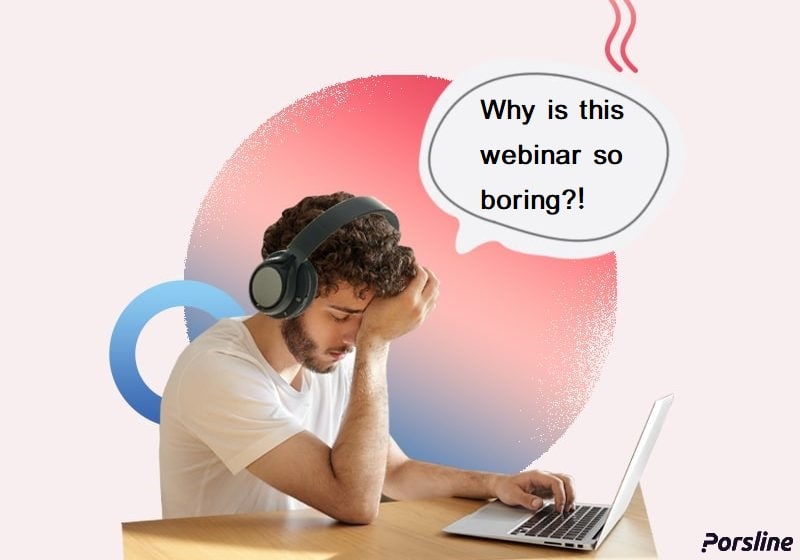How to best measure the effectiveness of a webinar?

«Our company has held several webinars and 90% of the participants were satisfied!» Now where did this percentage come from? and with what level of confidence do we say it? The answers to these questions are very simple: from the results of the webinar survey and with high reliability and accuracy.
Conducting a webinar survey is a method to get to know the effectiveness of the webinar and the satisfaction of its participants.
In this post, we will learn about the importance of conducting a webinar survey, how and when to conduct a webinar survey and the best questions for this survey. If you or your company are holding training webinars or online events, this post is a comprehensive guide to measuring the effectiveness of a webinar.
What exactly are we talking about when we talk about a webinar survey?
Most individuals and companies hold webinars or online events to achieve the following goals:
- Attract potential customers and increase the audience.
- Increase the audience participation rate and make them follow you.
- Retain previous customers.
- Create brand awareness.
- Get to know your audience or potential customers.
But just holding a webinar does not fulfill the above goals. Here is where a webinar survey comes into play.
Receiving feedback and continuous improvement of the webinar is another part of the work that we need to do if we wish to achieve the goals of the webinar. If the webinar participant survey is done correctly using the online survey tool, it will give us a realistic view of the webinar status and progress made in it.
In this type of survey, we ask people who have registered in the webinar questions related to pre-, during-, and post-webinar.
A sense of belonging is formed when the audience presents a suggestion or criticism. This sense of belonging is the beginning of a human connection.
What are the goals of conducting a webinar survey?
By conducting a webinar survey, future decisions will not be only based on your personal thoughts and feelings, but are made to gain the audience satisfaction.
Among other goals and benefits of a webinar survey, the following can be mentioned:
- Creating a deep connection with the audience
When the audience shares a suggestion or criticism with you, a sense of belonging is formed.
This sense of belonging is the beginning of a human connection. In addition, by obtaining information about the participants and identifying their interests, you can get a more accurate understanding of their needs.
- Evaluating the webinar quality and effectiveness
By conducting a webinar survey, you evaluate the effectiveness of the webinar, the content presented, the skills of the presenter, the quality of the webinar, etc.
- Collecting data to improve subsequent webinars and events
Webinar survey data and results help you choose better topics for future events or change the content and your other plans to increase audience participation.
- Improving marketing and advertising in subsequent webinars and events
Audience feedback helps you do better in marketing and advertising for future webinars, as you can improve your webinar registration form and attract more potential customers.
When is the best time for conducting a webinar survey?
Webinar participants can be surveyed at three times:
Pre-webinar Survey
Before the webinar, conduct a short survey via email or even social media. By conducting this survey, you will understand the needs of the audience before the webinar and handle them in the webinar content.
Of course, it is not necessary to pay attention to all feedback when preparing webinar content. It is enough to handle the most frequent questions of the audience in the webinar content.
During-the-webinar survey
A survey during the webinar has the highest participation rate. People may ignore emails inviting them to fill out a survey, but few people decline from filling out a short survey during a webinar. Note that the survey must be short and visible somewhere on the webinar page and can be filled out there.
Post-webinar Survey
Two hours at most after the webinar, send a survey to people who registered for the webinar, whether they attended or not.
Remember to invite participants to fill out the survey at the end of the webinar.
Some people prefer watching the webinar video rather than attending the webinar. Do not forget these people when you conduct the webinar survey. Although these people did not attend your webinar, they are still an audience with valuable ideas.
A comprehensive guide to designing effective surveys; For those who believe in data collection!
How to Conduct a Webinar and Online Event Survey? Types of Survey Questions
You can use a variety of questions to create a webinar survey. The most common types of questions in a webinar survey are the following:
Demographic questions
One of the most important aspects of surveys and questionnaires is identifying the characteristics of the audience. So demographic questions are an important part of your webinar survey questions.
Demographic questions are questions that allow you to classify and identify the target audience by asking about the characteristics of that community. Questions such as age, gender, occupation, income, etc. are among the appropriate demographic questions for events, conferences, and webinar surveys.
Satisfaction measurement questions
These questions are related to evaluating audience satisfaction with content quality, knowledge, experience, the eloquence of speakers, the quality of the webinar holding, and other things such as audio and video quality.
You should ask a separate question for each of the above. You can use ranking, rating, or Likert scale questions to ask these questions (you can access these types of questions in your Porsline account).
Survey questions about subsequent events topics
In a webinar or lecture survey, suggest topics for future events in the form of a multiple-choice question and ask the audience for their opinion on each of these topics.
You can also put open-ended questions and ask for the audience’s feedback on various parts of the webinar and online event without affecting their opinions.
An open-ended question is a question whose answer is descriptive in the form of a textual explanation and does not present limited options to the audience. Of course, it is difficult to analyze the answers to open-ended questions, especially if you have a large audience. If you ask open-ended questions in the survey despite the presence of a large audience, it is better to pay attention only to the frequently repeated words in the answers and analyze the results based on that.
Likert-scale questions
Such questions provide a numerical range for the audience to measure their satisfaction and loyalty. They are effective in measuring loyalty and receiving relative opinions. For example, you ask the participant: How likely are you to introduce our webinars to your friends and colleagues? Give them a numerical range from zero to ten, choosing between “I would recommend this webinar to others” (score 10) and “I would not recommend this webinar at all” (score zero).
What questions should we ask before, after, and during the webinar?
Here we present some common questions in creating surveys, webinars, and online events. You can use these questions or get ideas from them to create an online survey.
Pre-webinar survey questions
- Which speaker are you most excited to see?
Knowing the answer to this question, you can prepare the webinar so that you will devote more time to the speech of the person who has been the most liked by the majority, and thus attract more attention from the audience.
- Have you participated in any of our webinars or events before?
This question will show you the returning rate of the customers or audience. A high number of loyal audience indicates that your topics and content are suitable for your target audience.
- How were you informed about this webinar?
Knowing how your audience is informed will help you choose the best platform to promote your upcoming webinars. The increase in advertising on that platform leads to an increase in the number of participants in the webinar.
- Why do you participate in this webinar?
The answer to this question helps us know the attractive aspects of the webinar, so we collect all the topics that are attractive to people and discuss them in the webinar.
- Which device do you use to watch the webinar?
People use different devices such as mobile phones, tablets, and PCs to participate in the webinar. You should make sure that the platform where you hold the webinar is available on all these devices.
Survey questions during the webinar
- Have you had any technical problem during the webinar?
During the webinar, technical problems may occur, such as audio and video interruptions, inability to post comments, etc. The technical team should solve the problem or provide assistance to the participant. For this question, you can place a separate survey in a corner of the webinar page.
- What topic would you like the webinar host to talk about?
By asking this question, you make sure that the participants will get what they want from the webinar since the satisfaction of the participants turns them into loyal audience or customers.
- Do you have any other questions?
Asking this simple question during the webinar is very important. Ask this question in the form of an open-ended question in the survey. You have to know that answering the questions by the participants greatly increases their satisfaction.
Post-webinar survey questions
- How would you rate the webinar?
This question should be asked in the form of a rating or Likert-scale question. Its answer indicates the level of satisfaction of the participants with the webinar.
- How do you rate the webinar speaker?
A good speaker makes the webinar attractive to the participants. The speaker should present the content to the audience in a friendly manner and sometimes with humor.
- Technically, how do you rate the webinar?
The correct and flawless implementation of the webinar requires a platform with the least defects. The answer to this question will help you fix technical problems or prompt you to use a better webinar platform in the future.
- Did the webinar meet your expectations?
With this question, you can evaluate the level of satisfaction of the participants more accurately. It helps you improve future webinars to meet participants’ expectations.
- How do you rate the communication tools in the webinar?
When you hold a webinar, it is better to consider a method to inform the participants about the other people present in the webinar to communicate and build relationships among them, as some webinar organizing platforms provide you with this possibility.
- Are you still in touch with the people you have met at the webinar?
The next step for successfully building relationships is to continue the communication after the webinar. Building relationships is one of the attractive factors for participating in webinars. Make sure your audience is close to their relationship-building goals.
- Which part of the webinar did you like the most? Which part did you like least?
This question helps to better understand the needs and sensitivities of the audience.
- Was the webinar platform easy to use?
The platform for conducting a webinar should be designed so that everyone can easily use it regardless of their level of education. This factor plays an important role in satisfying the participants. By asking this question, you can know whether you have chosen the right platform to conduct your event or not!
- How likely are you to recommend this webinar to your friends and colleagues?
This type of question should be asked in the form of a Likert-scale question. If you get a high score, your webinar is on the right track.
- How likely are you to attend our upcoming webinars?
This question directly determines who has the tendency to become a loyal customer. By identifying those people, you will get to know your target group better.
- How do you rate the webinar participation fee compared to its results?
If the participation in your webinar or event requires attendees to pay a certain fee, you should ask in your post-webinar survey about the satisfaction and expectation of the audience with the participation fee.
- What are your suggestions for improving the webinar?
This question is asked as an open-ended question. The answer to this question will be a guide to help you design future webinars.
How to send and share the webinar survey form?
Before it was possible to create online surveys, the process of conducting paper surveys was difficult, costly, and lengthy. Fortunately, nowadays, it is enough to use webinar survey tools such as Porsline and send a link to conduct the survey.
Here are some methods of sending the survey form to the webinar participants, which is available to you on Porsline:
- Sharing the survey link via e-mail or SMS
In this method, the webinar survey link is sent to the participants’ email addresses or mobile phones.
This method is suitable for pre-webinar and post-webinar surveys. If the sending time and the text of the email or SMS are well chosen, the participation rate in the survey will be significant.
- Sharing via social media networks
By sending the webinar survey form link through each of the social networks, more people can participate in this survey. This method of sending a survey form is suitable for conducting a pre-webinar survey.
- Placing the survey form on the website of the event and webinar
When people visit the website, they see the webinar survey form and answer it. The survey form can also be displayed as a pop-up window.
To conduct a pre-webinar survey, we recommend placing the survey link on the webinar registration page. In this case, the probability of participating in the survey is higher. At the end of the webinar, you can also invite the attendees to participate in the survey by displaying a pop-up window.
Conclusion
Invest your money and effort in the right method by creating and conducting webinars and online event surveys. You may not believe it, but your audience is the best source for exchanging ideas, analyzing results, and improving your next webinars. Listen to the participants’ opinions and feedback by measuring the level of their satisfaction.
To create any type of online survey, you can now create a free Porsline account and enjoy its unique features.




